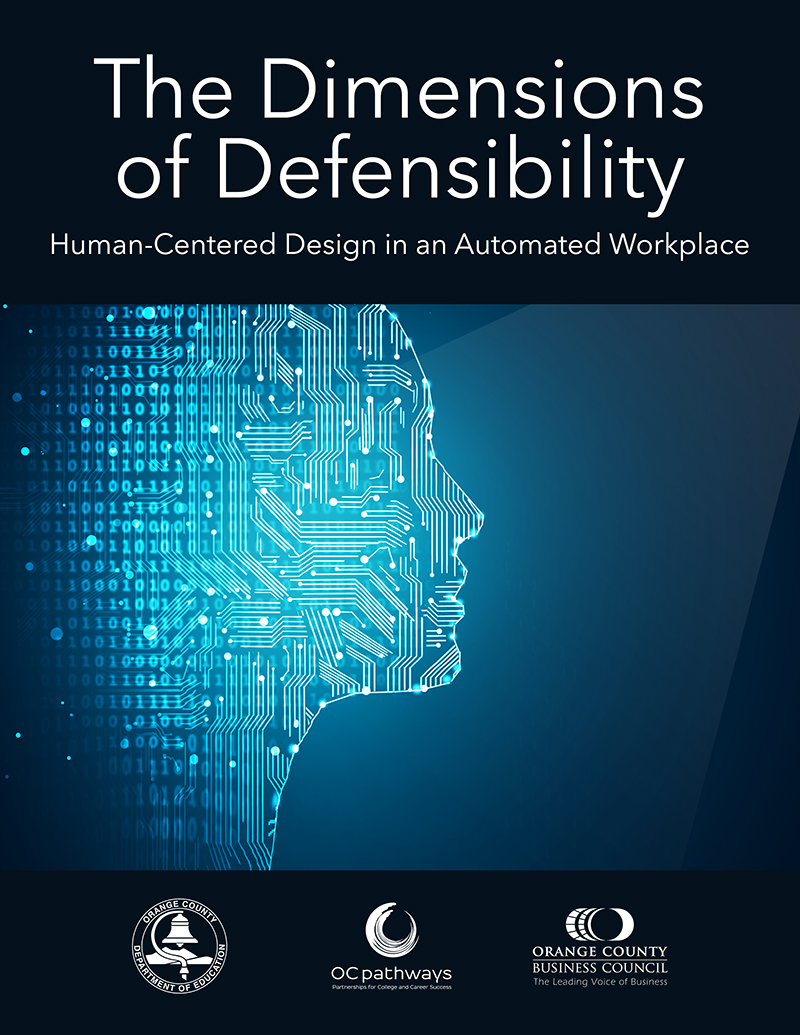Experts and economists have in recent years sounded the alarm on jobs believed to be vulnerable to automation, artificial intelligence and other technological disruptions.
But which careers will thrive in the new economy, and which skills will be most coveted? A new report released by OC Pathways in partnership with the Orange County Business Council and the Orange County Department of Education seeks to shed some light.
“The Dimensions of Defensibility: Human-Centered Design in an Automated Workplace” scours occupational characteristics from the Bureau of Labor Statistics and other data points to paint a picture of how automation will impact the labor market — and how workers can adapt to these changes in Orange County and beyond.
The analysis, released Oct. 30, was authored by OCBC Chief Economist Dr. Wallace Walrod and Petersen Walrod, with input from OCDE Chief Academic Officer Dr. Jeff Hittenberger and former OC Pathways Executive Director Amy Kaufman.
“Most research in this space has focused on disruption, on the negative impacts of workplace automation, digitization and other new technologies,” Dr. Wallace Walrod told the OCDE Newsroom. “We decided to flip this by analyzing what would be truly defensible in terms of the future of work.”
With varying degrees of anxiety, most have come to accept that automation will radically restructure future workplaces — and likely sooner than later. A January 2017 report by the McKinsey Global Institute estimates that nearly half of the duties that workers perform in the global economy have the potential to be automated simply by adapting technologies that are already available.
Yet, as the Defensibility report notes, some jobs will continue to thrive based on the high degree of creative intelligence they require. Civil engineers, fashion designers, landscape architects and physicists are listed among the careers that have low automation potential. Even less vulnerable to technological growth are clergy, lawyers, chief executives, and marriage and family therapists.
Eye-opening research
“The Dimensions of Defensibility” is billed as one of the first reports to go beyond focusing on what careers are threatened by automation to specifically address the concept of “defensibility,” a term that describes the levels to which jobs are resistant to technology’s rapid encroachment. Moreover, the report identifies the characteristics that can help workers stay relevant in an increasingly automated economy.
“Much of what we found was eye-opening,” Walrod said. “Previous research focused on the connection between technical skills and defensibility. Human resources departments focus mainly on technical skills as part of their baseline hiring practices.”
Yet skills like active learning and complex problem-solving emerge as the strongest predictors of defensibility, while more tangible skills like equipment maintenance, installation and troubleshooting trend in the opposite direction.
Similarly, some work activities are considered highly defensible, including developing objectives and strategies, thinking creatively, and providing consultation and advice to others. Abilities that are highly defensible include fluency of ideas, originality, and deductive and inductive reasoning.
“Robots can replace many functions,” the report concludes. “But for the foreseeable future they will not replace the human capacity to respond in creative ways to non-routine demands in collaboration with diverse colleagues, taking into account the emotional dimensions of human needs and longings.”
Education and defensibility
Naturally, there is a strong correlation between education and defensibility. But jobs at all levels of the labor market are vulnerable to automation, including many that require extensive education.
This illustrates some of the complexities and nuances of defensibility. While many researchers have identified manual labor as a likely victim of emerging workplace technologies, the report notes that some kinds of manual labor are difficult to perform with robotics, particularly jobs that require non-routine thinking. By contrast, the report says automation poses a great threat to cognitive jobs that are more routine.

Either way, education will have to adapt to prepare workers for an uncertain future. Strategies like project-based learning and integrated career pathways — these blend rigorous academics with hands-on career training — offer promise, according to the report, which specifically calls out the California Partnership Academies program and Ideate High Academy in San Diego as examples, along with OCDE’s own OC Pathways initiative.
“OC Pathways brings together Orange County’s districts, ROPs, colleges, universities and business and community partners like OCBC to expand students’ opportunities to cultivate the defensible qualities that we refer to as 21st-century competencies,” said Jeff Hittenberger, OCDE’s chief academic officer. “These go beyond the idea of ‘soft skills’ because they are, in fact, the defensible human qualities that will assure success in college, career and life — communication, collaboration, creativity, critical thinking and character.”
The analysis further cites the concept of “human-centered design thinking” as a strong foundation for training the next generation of workers. Embraced by both industry leaders and educators, design thinking generally refers to the ability to leverage creativity to solve problems with a specific focus on the end-user’s experience.
“Human-centered design thinking as it relates to education and training seems to capture many of the aspects of our research findings,” Walrod said, “especially in terms of emphasizing the importance of students getting the right kind of education and training experience.”
“While this research raises as many questions as it answers about the future of work,” he said, “it leaves us with a whole new set of fruitful questions and socially important directions to consider about how best to prepare our students for the rapidly approaching automated workplace.”

